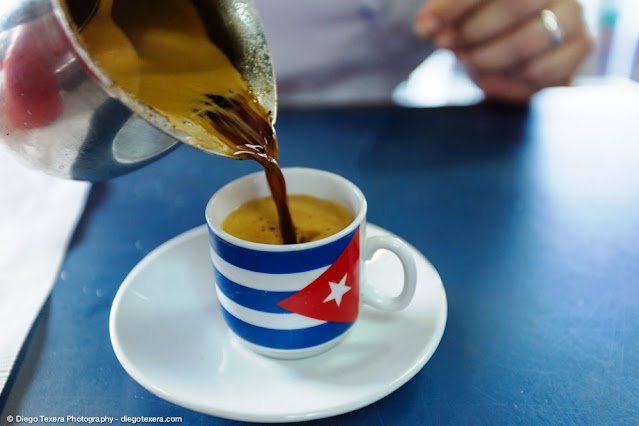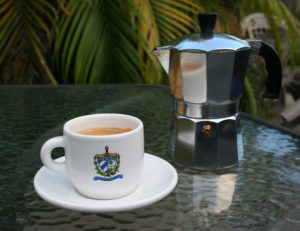EL CAFÉ CUBANO Y EL YA DESAPARECIDO DE LOS ESTANTES CUBANOS EL AROMÁTICO “CAFE DE 3 QUILOS”. PHOTOS
En Cuba a los centavos se les dice “quilo”. En el mercado de la nostalgia de Miami, el Latin Miami Café en Hialeah en sus inicios vendía café a 3 centavos la tacita, tal como tradicionalmente se ofertaba en Cuba en casi todas las esquinas de La Habana y la mayoría de ciudades de la isla antes de la revolución.
El café de 3 quilos es parte inseparable de la memoria de nuestro pueblo. En Cuba el quilo es la unidad monetaria de menor cuantía, por lo tanto no puedes dividirlo en otras monedas. Hay que recordar la frase: “el quilo no tiene vuelto”. O aquella que dice: “me sacaron el quilo”, que es hacer sudar a alguien y trabajar con gran fatiga y desvelo. La antigua peseta española se componía de cien céntimos a los que popularmente se les llamaba quilo. De ahí viene la costumbre cubana de llamar quilo a la moneda de un centavo.
Aunque algunos pensaban que el modesto quilo no tenía mucho valor “no vale ni un quilo”, se decía antes en Cuba para indicar que algo tenía poco valor), con un quilo se podían comprar muchas cosas, como por ejemplo: un pirulí, una melcocha, un cigarro, un chicle, azúcar, sal, una galleta, un caramelo, un vaso de agua de seltz o carbonatada, por señalar algunas. Y con tres quilos tomabas una excelente taza de café. Una popular tienda habanera, que vendía artículos muy baratos se llamaba “La Casa de los Tres Quilos” y estaba situada enfrente de la iglesia de Reina y Belascoaín. Y por supuesto estaba la cadena de tiendas Woolworth, popularmente llamados Ten Cents o Diez Centavos. En La Habana aún se conservan los Ten Cents de Obispo, Galiano, Monte, Vedado, y La Copa, en Miramar. En el interior había otros cinco en Cienfuegos, Santa Clara, Matanzas, Camagüey y Santiago de Cuba.
Y mis contemporáneos y muchos otros recordarán que solían tomar café a 3 centavos, con su vaso de agua fría con hielo y gastaban otros 2 centavos comprando cigarros sueltos. Un amigo de mi padre puso inicialmente un puesto de venta de café de 3 centavos, a los dos años ya tenía 5 establecimientos similares. Y eso que era rara la esquina donde no hubiera uno al menos. No importaba tanta competencia, la demanda siempre era mayor porque un cubano no podía pasar frente a un lugar donde vendieran café que no se tomara uno.
EL CAFÉ EN NUESTRAS TRADICIONES
Se arraigó tanto el café en nuestras tradiciones y prácticas cotidianas, que hoy los mayores que nos preceden hablan, con nostalgia, de cómo el inconfundible y estimulante aroma del grano tostado y recién colado estaba presente en cualquier parte de cada localidad y motivaba a muchos a consumir una taza del auténtico café cubano, humeante, sabroso, tentador y fuerte, por el módico precio de tres centavos.
Casi todos cumplían ese ritual a cualquier hora del día y todas las marcas en el mercado, suministraban la especie arábiga al 100%; eran muchas, pero todas con calidad indiscutible.
Lo mismo pudiéramos decir del amanecer clásico del cubano. La taza de café era imprescindible para comenzar adecuadamente el día, para no hablar del siempre popular y altamente demandado desayuno básico: un nutritivo café con leche y pan con mantequilla. Y si era en el campo, el gran jarro de café recién colado con unas viandas y unos pedazos de carne de puerco.
Pero lo más tradicional para los cubanos que están en los más disímiles confines del mundo, en su casa, como gesto cordial de bienvenida, seguramente le ofrecerán al visitante esa taza de café, sea de donde sea su origen pero hecho a la cubana, bien fuerte y caliente, pero siempre tomando el café con la taza y el platillo debajo, que es una costumbre muy vieja de los cubanos.
THE CUBAN COFFEE AND THE AROMATIC “COFFEE DE 3 QUILOS” NOW DISAPPEARED FROM THE CUBAN SHELVES. PHOTOS
In Cuba, cents are called “quilo”. In the nostalgia market of Miami, the Latin Miami Café in Hialeah initially sold coffee for 3 cents a cup, just as it was traditionally offered in Cuba on almost every corner of Havana and most cities on the island before. of the revolution.
The 3 kilo coffee is an inseparable part of the memory of our people. In Cuba the kilo is the smallest monetary unit, therefore you cannot divide it into other currencies. We must remember the phrase: “the kilo has no return.” Or the one that says: “they took the piss out of me”, which is making someone sweat and work with great fatigue and sleeplessness. The old Spanish peseta was made up of one hundred cents, which were popularly called quilo. That’s where the Cuban custom of calling the one cent coin comes from.
Although some thought that the modest kilo did not have much value “it is not worth a kilo”, it was previously said in Cuba to indicate that something had little value), with one kilo you could buy many things, such as: a lollipop, a marshmallow, a cigarette, a piece of gum, sugar, salt, a cookie, a candy, a glass of seltzer or carbonated water, to name a few. And with three kilos you had an excellent cup of coffee. A popular Havana store that sold very cheap items was called “La Casa de los Tres Quilos” and was located in front of the Reina y Belascoaín church. And of course there was the Woolworth chain of stores, popularly called Ten Cents. In Havana the Ten Cents of Obispo, Galiano, Monte, Vedado, and La Copa, in Miramar, are still preserved. Inside there were five others in Cienfuegos, Santa Clara, Matanzas, Camagüey and Santiago de Cuba.
And my contemporaries and many others will remember that they used to drink coffee for 3 cents, with their glass of cold water with ice and spent another 2 cents buying single cigarettes. A friend of my father’s initially started a stand selling 3 cent coffee, within two years he already had 5 similar establishments. And it was a rare corner where there wasn’t at least one. It didn’t matter so much competition, the demand was always greater because a Cuban couldn’t pass by a place that sold coffee that didn’t drink one.
COFFEE IN OUR TRADITIONS
Coffee became so rooted in our traditions and daily practices that today the elders who precede us speak, with nostalgia, of how the unmistakable and stimulating aroma of the roasted and freshly brewed grain was present in every part of each town and motivated many to consume a cup of authentic Cuban coffee, steaming, tasty, tempting and strong, for the modest price of three cents.
Almost everyone fulfilled this ritual at any time of the day and all the brands on the market supplied 100% of the Arabica species; There were many, but all with indisputable quality.
The same could be said of the classic dawn of the Cuban. The cup of coffee was essential to properly start the day, not to mention the always popular and highly demanded basic breakfast: a nutritious coffee with milk and bread with butter. And if it was in the countryside, the large jug of freshly brewed coffee with some food and some pieces of pork.
But the most traditional thing for Cubans who are in the most dissimilar corners of the world, in their home, as a cordial gesture of welcome, they will surely offer the visitor that cup of coffee, wherever its origin is but made Cuban-style, well strong and hot, but always drinking the coffee with the cup and saucer underneath, which is a very old Cuban custom.
Agencies/ Wiki/ NostalgiaCubana/ Carlos Rodriguez Búa./ Extractos/ Excerpts/ Internet Photos/ Arnoldo Varona/ www.TheCubanHistory.com
THE CUBAN HISTORY, HOLLYWOOD.








